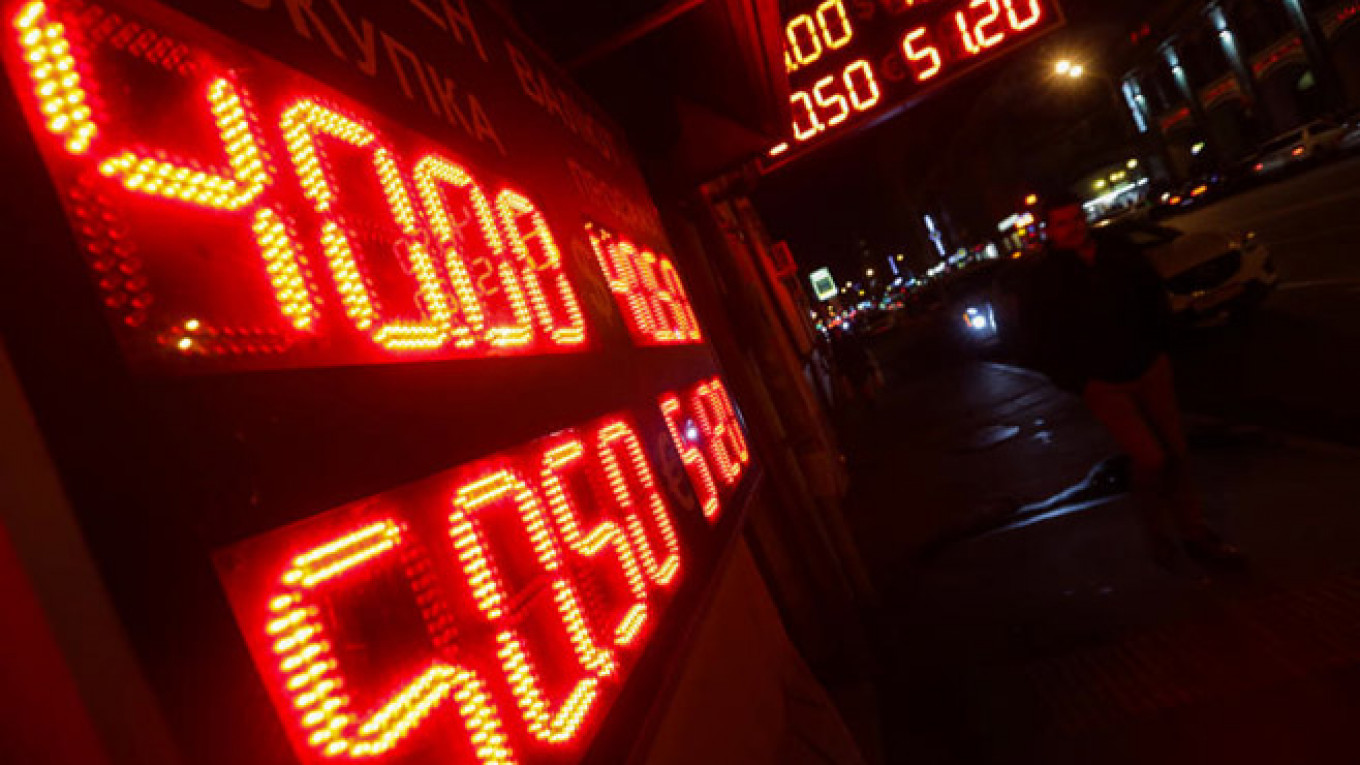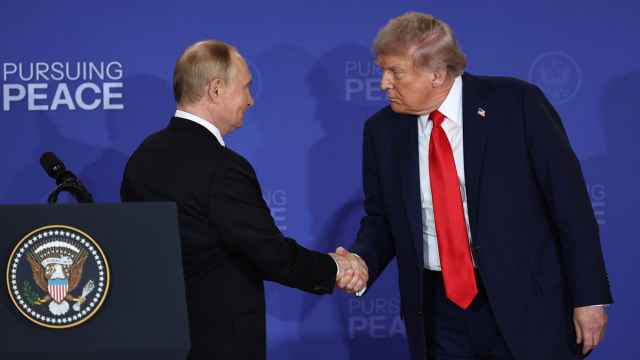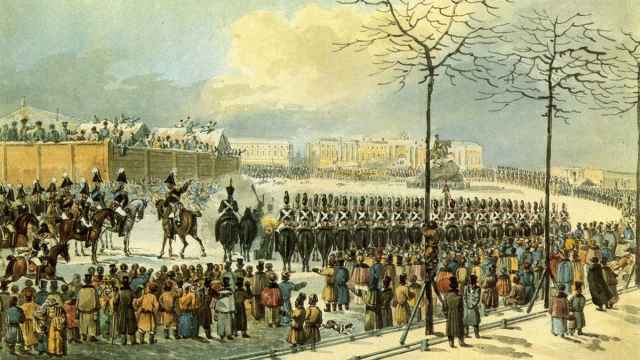On Wednesday, the ruble's exchange rate against the U.S. dollar closed below 40, for many people a psychological line in the sand. The ruble has thus lost more than a fifth of its value since the start of the year and is a third lower than the rate 18 months ago.
That is a very painful move for any individual or company earning income in rubles but with U.S. dollar liabilities. The loss against the euro has been less severe, amounting to 12 percent so far this year as the European Central Bank is more inclined to let the euro-zone currency weaken against other major currencies in an effort to boost the region's flagging economy. But against the dollar and British pound, the greater likelihood is that the ruble will lose more before it settles.
Against the Russian Central Bank's currency basket, the ruble rate closed at 44.9 midweek and higher than the 44.4 threshold at which the Central Bank committed to intervening to slow the decline. This week the Central Bank has spent several billion dollars, not in an effort to reverse the trend but to slow the pace of decline. That is because the ruble exchange rate is now firmly magnetized to the price of crude oil.
If Urals finishes this year closer to $85 per barrel, the ruble will likely trade between 41 and 42 against the dollar. If Urals climbs back to $100 per barrel then we could see the ruble-dollar trade in the 38 to 38.5 range.
The Central Bank is not expected to expend too much of its reserves trying to hold the ruble's exchange rate against a falling oil price. It learned that expensive lesson in 2008 when it burned through $200 billion in a futile attempt to support the currency.
It was only when the oil price started to recover in mid-2009 that we finally saw ruble recovery. This time we may expect a number of periods of brief, albeit expensive, interventions in order to prevent a steeper free-fall that might provoke a public panic and a negative accumulator effect against the ruble.
It is tempting to link the ruble's demise with the country's actions in Ukraine and the resulting sanctions imposed by Western countries; a sort of just retribution that is squeezing the economy and that might finally start to undermine public support for President Vladimir Putin. That is wishful thinking because sanctions are not the major problem when it comes to the ruble.
There is no doubt that sanctions are hurting, especially those imposed in early September that added Sberbank to the list of state banks excluded from Western debt markets and the cut in the accessible debt limit to 30 days from 90.
That action severely squeezed liquidity in the Moscow FX Interbank market, sending the cost of borrowing higher and adding some pressure on the ruble. The high cost of borrowing, which had been rising for more than a year even before the sanctions, is also one of the major reasons for the slowdown in the economy
But while sanctions are hurting, this is not the full story. The real story is both more serious and somewhat encouraging. The ruble lost 10.5 percent against a basket of dollars and euros last year and another 8 percent in January and February of this year — before the sanctions started.
The major cause of ruble weakness in that period was the sharp slowdown in the economy, which saw growth of only 1.3 percent in 2013 compared with 4.3 percent growth two years previously.
The value of the ruble stayed relatively calm through the summer, even as sanctions were being ratcheted up, but since August has again fallen steeply. The reason this time is the equally steep fall in the price of oil. Since early August the ruble has fallen 9 percent against the dollar-euro basket and almost exactly mirroring the 8 percent decline in the price of crude oil over the same period.
And that is where the optimism kicks in. The ruble is behaving as a petro-currency, and the federal budget is dependent on hydrocarbon taxes for 50 percent of its revenue. It must be tempting for the government to impose some sort of capital controls and to use reserves to protect the ruble exchange rate. It has made clear that it will do neither. To do so would be a short-term populist move, a huge retro-step and much more damaging for post-sanction recovery and investment-flow prospects.
The greater priority now is to protect budget revenues, the ruble spending power of the accumulated sovereign wealth funds and as an indirect stimulus to local manufacturers. Last year the federal budget needed an average of $108 per barrel to balance. Over the first eight months of this year the budget ran a surplus equal to 2 percent of GDP, or almost $26 billion, despite a weaker oil price and a 7 percent rise in spending.
The reason for that is the weaker ruble. At the current exchange rate, this year's budget should balance with an average of $98 per barrel even allowing for the usual year-end surge in spending. That places Russia in a better position to live with a falling oil price than is the case with the major OPEC producers, whose currencies are pegged to the rising dollar.
The steepness of the decline in the oil price since mid-August has caught traders by surprise. The trigger was the sharp rally in the value of the dollar, against which the oil price has a very close historic reverse correlation. The coordinated actions against the Islamic State in Iraq and Syria, which raises hopes that there will be no oil-export disruption from the region, plus reports of still fast-rising U.S. oil production, also added to the negative oil story in recent weeks.
The momentum in the oil price, and therefore for the ruble, is very clearly downward. But the key driver is now OPEC, more specifically Saudi Arabia. In the past Saudi's oil minister has said that the kingdom considers $100 Brent as the right price for producers and consumers and is prepared to adjust production to achieve that price.
But as the organization prepares for a crucial production meeting at the end of November, it seems that Saudi Arabia is not so keen to give up market share nor do any favors for Iran, whose budget now needs $130 oil to balance. After almost four years of nearly $110 oil, Saudi Arabia and the other Gulf producers have the fiscal reserves to play hardball inside OPEC and allow the price to drift lower for several months.
In Russia, the Central Bank's strategy of allowing the ruble balance weaker oil is only a survivalist strategy. It does not in itself lead to future growth or accelerate much-needed reforms. But the more flexible ruble stance does mean that the government has more budget and domestic spending flexibility than it would have had if the Central Bank had tried to rigidly defend the currency.
The net result is that Russia can survive a lengthy sanction siege without risking a steep recession or social instability, even if against the backdrop of near growth stagnation. But make no mistake about it; the future direction of the ruble exchange rate is now more dependent on the U.S. Federal Reserve and Saudi Arabia than on Central Bank actions.
Chris Weafer is a senior partner with Macro Advisory, a consultancy advising macro hedge funds and foreign companies looking at investment opportunities in Russia.
A Message from The Moscow Times:
Dear readers,
We are facing unprecedented challenges. Russia's Prosecutor General's Office has designated The Moscow Times as an "undesirable" organization, criminalizing our work and putting our staff at risk of prosecution. This follows our earlier unjust labeling as a "foreign agent."
These actions are direct attempts to silence independent journalism in Russia. The authorities claim our work "discredits the decisions of the Russian leadership." We see things differently: we strive to provide accurate, unbiased reporting on Russia.
We, the journalists of The Moscow Times, refuse to be silenced. But to continue our work, we need your help.
Your support, no matter how small, makes a world of difference. If you can, please support us monthly starting from just $2. It's quick to set up, and every contribution makes a significant impact.
By supporting The Moscow Times, you're defending open, independent journalism in the face of repression. Thank you for standing with us.
Remind me later.








